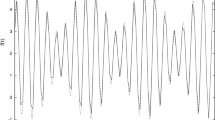Abstract
The fast orthogonal search (FOS) algorithm has been shown to accurately model various types of time series by implicitly creating a specialized orthogonal basis set to fit the desired time series. When the data contain periodic components, FOS can find frequencies with a resolution greater than the discrete Fourier transform (DFT) algorithm. Frequencies with less than one period in the record length, called subharmonic frequencies, and frequencies between the bins of a DFT, can be resolved. This paper considers the resolution of subharmonic frequencies using the FOS algorithm. A new criterion for determining the number of non-noise terms in the model is introduced. This new criterion does not assume the first model term fitted is a dc component as did the previous stopping criterion. An iterative FOS algorithm called FOS first-term reselection (FOS-FTR), is introduced. FOS-FTR reduces the mean-square error of the sinusoidal model and selects the subharmonic frequencies more accurately than does the unmodified FOS algorithm. © 2003 Biomedical Engineering Society.
PAC2003: 8780Tq, 0270Hm
Similar content being viewed by others
References
Adeney, K. M. Iterative orthogonal search techniques for identification of generalized single-layer networks. PhD thesis, Queen's University, Kingston, Ontario, Canada, 2002.
Adeney, K. M., and M. J. Korenberg. Fast orthogonal search for direction finding. Electron. Lett.28:2268–2269, 1992.
Adeney, K. M., and M. J. Korenberg. Fast orthogonal search for array processing and spectrum estimation. IEE Proc.-Vis. Image Signal Process.141:13–18, 1994.
Adeney, K. M., and M. J. Korenberg. An easily calculated bound on condition for orthogonal algorithms. Proceedings of the International Joint Conference on Neural Networks, 2000.
Adeney, K. M., and M. J. Korenberg. Iterative fast orthogonal search for mdl-based training of generalized single-layer networks. Neural Networks13:787–799, 2000.
Aitken, G., and McGaughey, D. Predictability of atmospherically distorted stellar wave fronts. In: Adaptive Optics, edited by M. Cullum. Munchen, Germany: Garching, 1996, No. 54 in ESO Conference and Workshop Proceedings, European Southern Observatory, pp 89–94.
Billings, S., S. Chen, and M. J. Korenberg. Identification of MIMO nonlinear systems using a forward-regression orthogonal estimator. Int. J. Control49:2157–2189, 1989.
Chon, K. H.Accurate identification of periodic oscillations buried in white or colored noise using fast orthogonal search. IEEE Trans. Biomed. Eng.48:622–629, 2001.
Desrochers, A. A.On an improved model reduction technique for nonlinear systems. Automatica17:407–409, 1981.
Dwight, H. B. Tables of Integrals and other Mathematical Data. London: Macmillan, 1960.
Hurst, K., T. Habetler, G. Griva, and F. Profumo. Speed sensorless field oriented control of induction machines using current harmonic spectral estimation. IEEE IAS Ann. Mtg.1:601–607, 1994.
Korenberg, M. J. Fast orthogonal identification of nonlinear difference equation and functional expansion models. In: Proceeding of the Midwest Symposium on Circuits and Systems. Vol. 1, pp. 270–276, 1987.
Korenberg, M. J.Fast orthogonal algorithms for nonlinear system identification and time-series analysis. Adv. Methods Physiol. System Modeling II2:165–177, 1989.
Korenberg, M. J.A robust orthogonal algorithm for system identification and time-series analysis. Biological Cybern. 160:267–276, 1989.
Korenberg, M. J., and K. M. Adeney. Iterative fast orthogonal search for modeling by a sum of exponentials or sinusoids. Ann. Biomed. Eng.26:315–327, 1998.
Korenberg, M. J., C. J. H. Brenan, and I. W. Hunter. Raman spectral estimation via fast orthogonal search. Analyst (Cambridge, U.K.)122:879–882, 1997.
Lathi, B. P. Modern Digital and Analog Communication Systems, 2nd ed. New York: Holt, Rinehart and Winston, 1989.
McGaughey, D. Spectral modeling and simulation of atmospherically distorted wave-front data. PhD thesis, Queen's University, Kingston, Ontario, Canada, 2000.
McGaughey, D., and G. Aitken. Measuring and modeling the low frequency behavior of atmospheric distortion. In: Astronomical Telescopes. New York: SPIE, 2000.
Nutt, K., M. Tarbouchi, D. McGaughey, and A. Chikhani. Current harmonic detection for induction motor speed sensorless control using fast orthogonal search. In: Proceedings of the American Control Conference, Anchorage, Alaska, May, 2002, Vol. 4, American Automatic Control Council, pp. 3088–3092.
Oppenheim, A. V., and R. W. Schafer. Digital Signal Processing. Englewood Cliffs, NJ: Prentice-Hall, 1975.
Press, W. H., B. P. Flannery, S. A. Teukolsky, and W. T. Vetterling. Numerical Recipes in C, the Art of Scientific Computing. Cambridge, U.K.: Cambridge University Press, 1988.
Zurada, J. M. Introduction to Artifical Neural Systems. St. Paul, MN: West, 1992.
Author information
Authors and Affiliations
Rights and permissions
About this article
Cite this article
McGaughey, D.R., Korenberg, M.J., Adeney, K.M. et al. Using the Fast Orthogonal Search with First Term Reselection to Find Subharmonic Terms in Spectral Analysis. Annals of Biomedical Engineering 31, 741–751 (2003). https://doi.org/10.1114/1.1574024
Issue Date:
DOI: https://doi.org/10.1114/1.1574024




